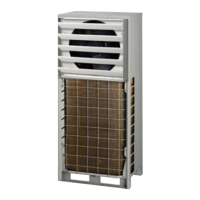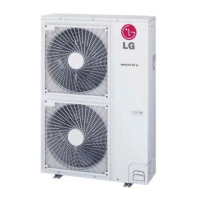63
Cautions for Refrigerant Leaks
Due to our policy of continuous product innovation, some specifications may change without notification.
©LG Electronics U.S.A., Inc., Englewood Cliffs, NJ. All rights reserved. “LG” is a registered trademark of LG Corp.
CAUTIONS FOR REFRIGERANT LEAKS
Amount of
Factory-Charged
Refrigerant per
Outdoor Unit
Amount of
Additional
Refrigerant
Trim Charge
If a structure includes two or more independent outdoor units,
the total refrigerant amount must be calculated for each system.
Refrigerant Concentration Limit (RCL) Calculations
To calculate total refrigerant amount per system:
Cautions for Refrigerant Leaks / Introduction
ASHRAE Standards 15-2010 and 34-2010 offer guidelines that address refrigerant safety and the maximum allowable concentration of refrig-
erant in an occupied space. Refrigerant will dissipate into the atmosphere, but a certain volume of air is required for this to occur safely. For
R410A refrigerant, the maximum allowable concentration is 0.026 lbs./ft
3
per 1,000 ft
3
of air in an occupied space. Buildings with twenty-four
(24) hour occupancy allow half of that concentration.
1
ASHRAE Standards 15 and 34 assume that if a system develops a leak, its entire refrigerant charge will dump into the area where the leak
occurs. To meet ASHRAE Standards 15 and 34, calculate the refrigerant concentration that may occur in the smallest room volume on
the system, and compare the results to the maximum allowable concentration number (see following pages for information on how to calcu-
late the refrigerant concentration).
1
Also consult state and local codes in regards to refrigerant safety.
Verify the maximum refrigerant concentration level in the space where the indoor unit will be mounted meets the concentration limit for the
application.
1 1
American Society of Heating, Refrigeration and Air Conditioning Engineers, Inc. (ASHRAE). Atlanta, GA. ASHRAE, Inc. Information about
ASHRAE Standard 15-2010 / 34-2010 and addenda current as of the date of this publication.
Take appropriate actions at the end of HVAC equipment life to recover, recycle, reclaim or destroy R410A refrigerant according to applicable
US EPA rules.
Space Unit
Direction of Refrigerant Flow
Indoor Unit
Zone into which the
entire charge of
refrigerant leaks.
Indoor Unit Indoor Unit
Indoor Unit
Figure 67: Example of Where R410A Refrigerant Might Leak.
Total System
Refrigerant
Charge
+ =
To calculate the potential refrigerant concentration level (RCL):
1. Measure the occupied space dimensions (in feet).
2. Calculate the cubic foot volume of air in the smallest occupied space. (To obtain a detailed overview of the RCL, perform the same cal-
culations to the second smallest zone, the third smallest zone until the RCL is obtained for all zones. Also, pay special attention to areas
such as basements, etc., where refrigerant cannot dissipate easily.)
3. Divide the refrigerant charge of the Multi V system serving the area in pounds by the results of step 1.
4. If the calculation indicates that the potential refrigerant concentration level is higher than the allowed RCL, increase the cubic volume of
the smallest occupied space or modify the piping system design.
5. The allowable RCL limit for most applications must be equal to or less than 0.026 lbs./ft
3
. However, in special occupied spaces, such as
hospitals and nursing homes, where occupants may have limited mobility, the allowable RCL limit is cut in half. See ASHRAE Standard
34-2007 and local codes for detailed information.
1
RCL (lbs./ft
3
) =
Total System Refrigerant Charge (lbs.)
Volume of Smallest Occupied Space (ft
3
)

